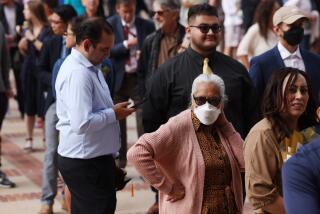Data on County’s HIV Cases Revised to Lower Figure
- Share via
FLORENCE, Italy — New and more accurate estimates by the Los Angeles County Department of Health Services indicate that between 37,200 and 42,500 people with human immunodeficiency virus infection were living in the county at the end of 1989.
The estimates for the county--which translate to between one infected person in 204 and one in 233--are slightly higher than the national average infection rate with the AIDS-causing virus, which is about one in 250.
The figures, released Wednesday at the International Conference on AIDS, are far lower than previous estimates. But that is primarily because of improved statistical methods, and the figures do not offer any relief to the county health system, already hard-pressed to meet the needs of HIV-infected people, particularly for care outside the hospital and for expensive medications.
“We have obtained these statistics by two independent means and the results are very similar,” said Dr. Peter R. Kerndt, the director of county’s AIDS epidemiology program. “This lends credibility to our estimates.”
But Kerndt stressed in an interview that the medical needs of HIV-infected individuals are likely to continue unabated and that new infections continue to occur, particularly in intravenous drug users, blacks and Latinos.
“Medical care services for HIV-infected people will continue to increase throughout the coming decade,” Kerndt said. “The vast majority of those currently HIV-infected have not yet (received medical attention). In fact, most are not aware that they are infected.”
Previous estimates placed the number of HIV-infected individuals in the county at between 55,000 and 112,000. They were prepared in 1989 and based on less reliable methods, according to Kerndt, who had previously indicated that they were probably too high.
As the scientific understanding of HIV has increased, public health officials have focused more attention on those who have yet to become severely ill.
Over the last decade, about 12,800 AIDS cases have been reported in Los Angeles County, and 70% of those individuals have died, according to county statistics. The approximately 4,000 living AIDS patients in the county represent only about 10% of the total number of HIV-infected individuals.
Kerndt and his colleagues used two methods to estimate the number of HIV-infected. One involves calculating backward from the number of diagnosed AIDS cases, taking into account scientific information about the typical time from initial infection with HIV to the development of AIDS. For example, it is estimated that about half of HIV-infected individuals develop AIDS within 10 years of acquiring the virus.
According to Kerndt, experts in AIDS statistics believe that back calculation is the most accurate estimation method currently available.
The second method uses data from three “sentinel” hospitals in the county. They are part of a federal network of hospitals where blood samples from patients are tested anonymously for HIV infection to help officials determine the extent of infections in the country. The names of these hospitals have not been made public.
County officials estimated that between 16,900 and 22,000 Anglos are HIV-infected, as are 8,200 to 8,900 blacks and 6,000 to 10,900 Latinos.
About 35,500 infected men are believed to have acquired the virus through sex with another man. In addition, about 3,000 individuals are thought to have been infected through intravenous drug use, and 3,500 through other routes, including blood transfusions, perinatal transmission and heterosexual intercourse.
The analysis found that most HIV-infected county residents acquired the virus between 1980 and 1984. The peak year was 1982, when as many as 12,900 people may have become infected, Kerndt said.
New infections, particularly in gay and bisexual Anglo men, appear to have dropped off markedly beginning in 1985, the year the blood test to detect HIV infection became available.
The number of AIDS cases in the county appears to have peaked between 1989 and 1991 at about 3,100 a year, Kerndt said. Starting in 1991, the AIDS case total may decline by several hundred each year. But a decline could be prevented by any increase in new infections in intravenous drug users, blacks and Latinos, or higher rates of heterosexual transmission in general.
HIV Infection
A look at human immunodeficiency virus infections in Los Angeles County for 1989.
NUMBER OF GROUP POPULATION % INFECTED HIV-INFECTED *Anglos 3.46 million 0.47% to 0.62% 16,900 to 22,200 *Blacks 0.97 million 0.84% to 0.91% 8,200 to 8,900 *Latinos 3.12 million 0.19% to 0.35% 6,000 to 10,900 *Total 8.72 million 0.43% to 0.49% 37,200 to 42,500
SOURCE: Los Angeles County Department of Health Services. New data presented at Seventh International Conference on AIDS in Florence, Italy, based on two methods of calculating the number of HIV infections in the country.
More to Read
Sign up for Essential California
The most important California stories and recommendations in your inbox every morning.
You may occasionally receive promotional content from the Los Angeles Times.













